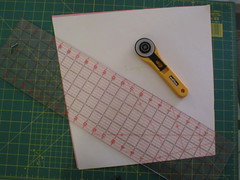Where are we?
Shell, check. Liner with pockets, check. Handles, check. Good! Since we have all those pieces ready, let’s put the bag together.
I hope the elves are on duty because I’m about to tell you how to put the bag together using my least favorite method. This is the method you see in most tutorials, and it works beautifullly… so master it! Then, grasshopper, you can move onto the “Cathy is a perfectionist and the pillowcase method ruffles her feathers” method. The “CIAPATPMRHF” method is going to be another mini-tutorial at a later date.
FYI: I am making all the pictures public so you can click on them.
Step 18: Place the liner inside the shell so that the right sides of each are facing.

The picture makes so much more sense than the words.
Step 19: Sew the top of the liner and shell together. Leave a 4-inch opening on one side.

You could also leave openings for the handles at this step.
Step 20: Reach inside the 4-inch opening. Grab a corner of the shell and pull it through the opening. This is going to turn the bag out so that only the right sides show.


It’s like magic, and you didn’t even need the elves.
Step 21: Push the liner back inside the shell.

That was a nice and easy step, probably the last easy one!
Step 22: Determine where you want to insert the handles.


I like the handles to be about 4-5 inches apart. Measure how wide your bag is, divide that number in half… this gives you the center point (my center pin is round yellow). Put a pin in the bag to locate the center. Now locate the handle insertion points. If your handles are 4″ apart, then put a pin 2″ to the right of the center pin, and 2″ to the left of the center pin (my pins are round white). These pins locate the inside edge of the handles. Make sure you mark both sides of the bag with pins. Use a seam ripper to open up the seam where you want to place the handles… make an opening slightly wider than your handles.
Did you notice I have more pins in the bag than I said you need for the handles? Those pins are optional.
I don’t like how this method of bag construction puts the seam between the liner and the shell at the very top of the bag. I want the seam to be behind the shell so I roll the seam down just a bit to the inside of the bag… the flat flower pins are holding the seam in place. If you don’t mind the seam being on top, you don’t have to roll it down.
Step 23: Insert the handles into the openings. The handles’ seams should face the inside of the bag. Pin in place.

The hardest part of this step is making sure you don’t twist the handles before inserting the other side.
Step 24: Make sure all your raw edges are tucked inside for a hem. Top stitch all around the bag.
Picture for Step 24: Imagine perfect top stitching around the top of the bag…
Your bag is now 95% complete. And it is so very wrinkled… ick!!! Go, use a medium hot iron to press it. Avoid melting the ribbon, and don’t use too much heat or the fusible interfacing will remelt and pucker. That is potential disaster after all your hard work.
Sit back and admire your work!
To be continued….



















































